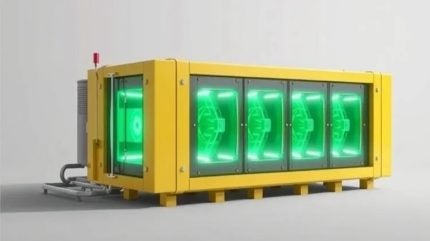
Researchers at South Korea’s Daegu Gyeongbuk Institute of Science & Technology led by Su-Il In have developed a new battery that utilises radiocarbon as a possible alternative to conventional lithium-ion batteries.
Su-Il In provided details of the betavoltaic battery at the American Chemical Society’s Spring 2025 meeting. Traditional lithium-ion batteries are widely used in a myriad of devices, from smartphones to electric vehicles. However, they come with inherent challenges, including limited lifespan and environmental concerns related to lithium extraction and battery disposal. The researchers are now looking beyond these energy solutions towards the use of radioactive materials that can harness energy for extended periods without the need for recharging. The basic premise involves the safe use of betavoltaic cells, a technology that converts radiation emitted by isotopes into electrical energy.
To develop the prototype, the researchers chose carbon-14, which emits beta particles that pose minimal risk to human health when properly shielded. The use of carbon-14 not only enhances safety but also reduces costs, as it is a by-product of nuclear reactors and can be recycled. This makes it an appealing option for creating reliable power sources that could function for decades or longer, presenting various possibilities for everyday technology.
Su-Il In described how the battery employs a unique design that places radiocarbon at both the anode and cathode, effectively increasing the energy conversion efficiency from 0.48% to a promising 2.86%. This dual placement allows the battery to harness maximum beta radiation, optimising the performance of the injected electrons into the semiconductor layer, leading to more effective electricity generation.
The prototype battery features advanced semiconductor technologies that boost energy conversion, using titanium dioxide, (commonly used in solar cells) combined with a ruthenium-based dye. This combination allows electrons emitted by the radiation to interact efficiently with the semiconductor, creating a chain reaction of electron transfer known as an “electron avalanche”. This amplifies the current produced, which is essential for the proper functioning of the nuclear battery.
The decision to employ a radiocarbon source which only emits beta rays ensures that the battery’s operation remains secure even in small-scale consumer applications. It could be used in devices that traditionally rely on lithium-ion batteries, such as implantable medical devices and remote sensors.
As well as improving battery performance the new prototype could have a positive environmental impact in view of the increasing reliance on rechargeable batteries. Lithium extraction is ecologically damaging raising questions about the sustainability as global demand surges. The shift towards a nuclear-powered battery could address these issues.
The long-term operational benefits of nuclear batteries, such as those that could last a lifetime in medical devices such as pacemakers, could eliminating the need for battery replacements reducing health risks associated with surgical procedures and addressing potential waste management issues associated with spent batteries.
While the current efficiency rates of these new betavoltaic designs may not yet exceed those of conventional lithium-ion batteries, the researchers believe they are on the verge of breakthroughs that could significantly improve their energy output. Future efforts will focus on optimising the physical configuration of beta-ray emissions and improving the efficiency of energy absorption at the device’s electrodes.







